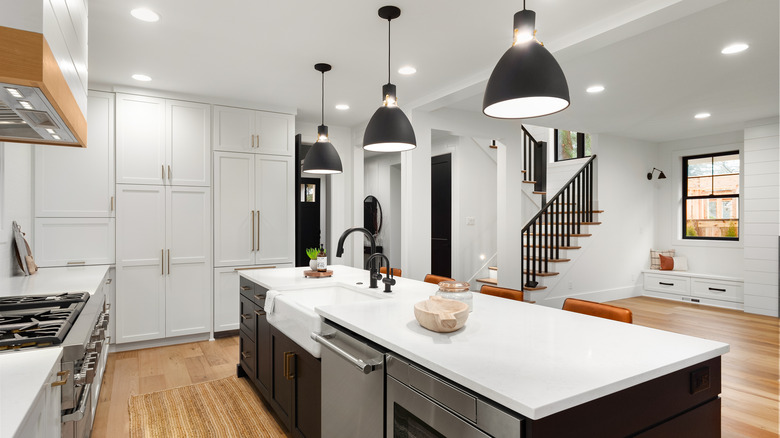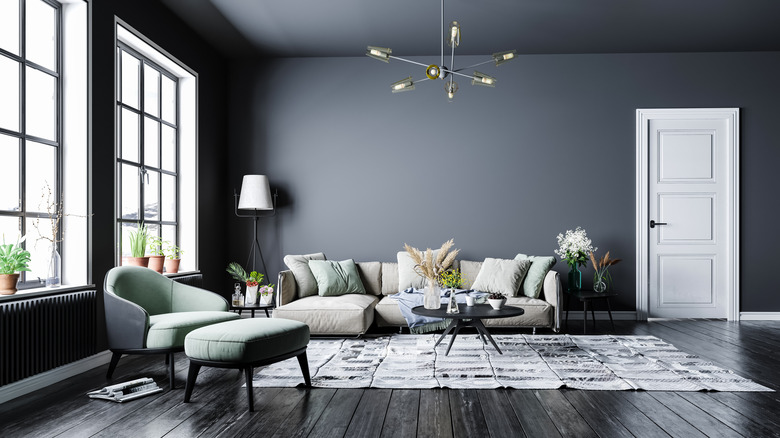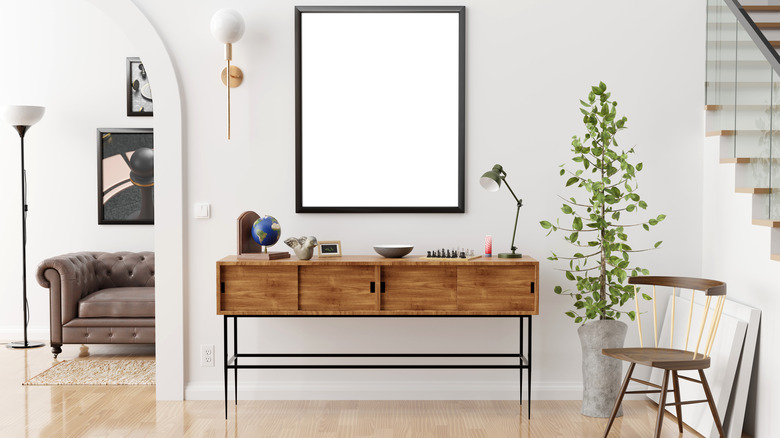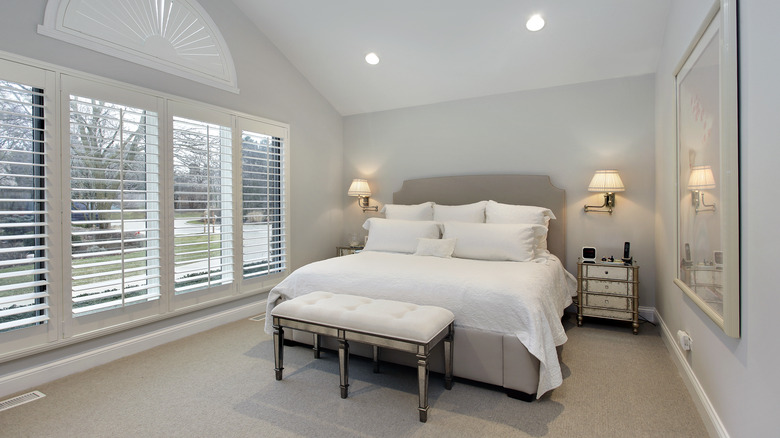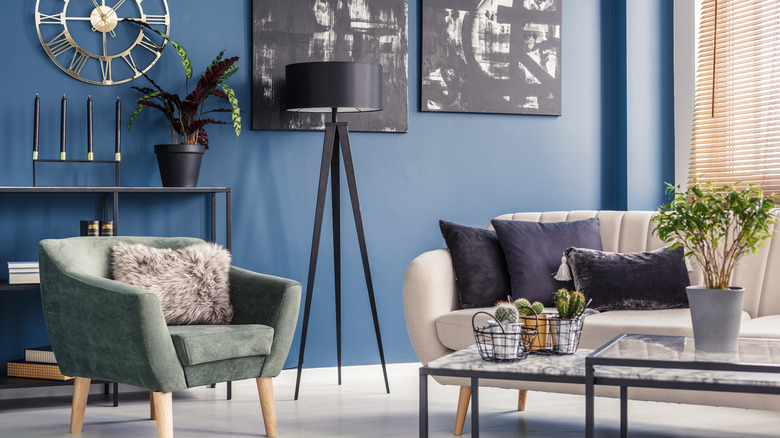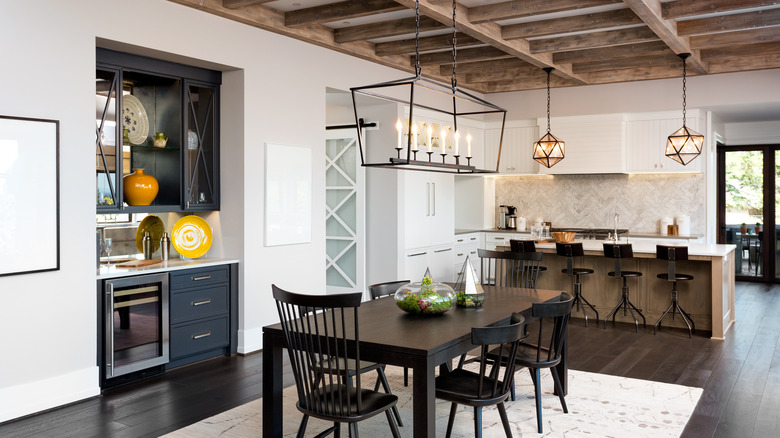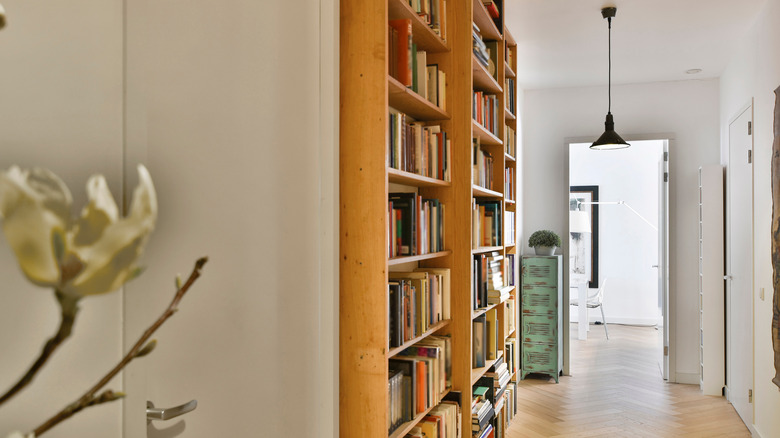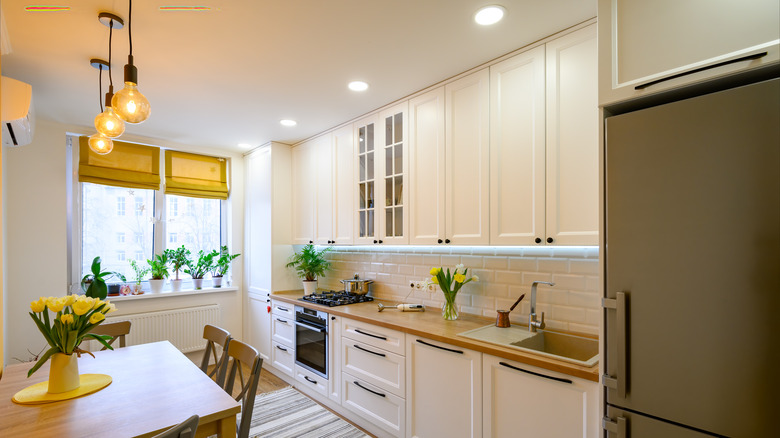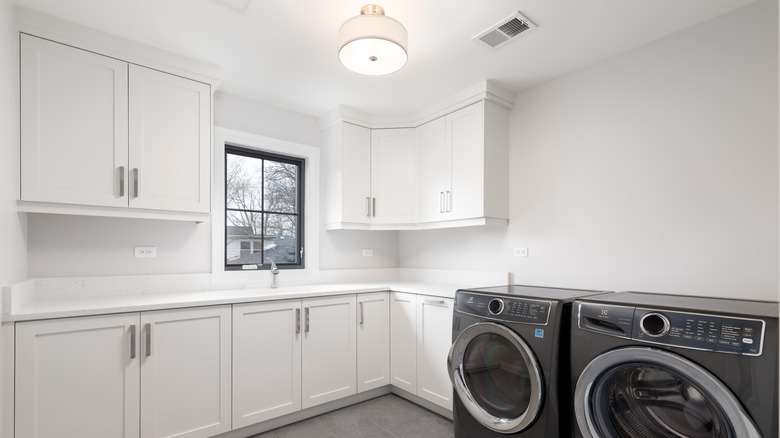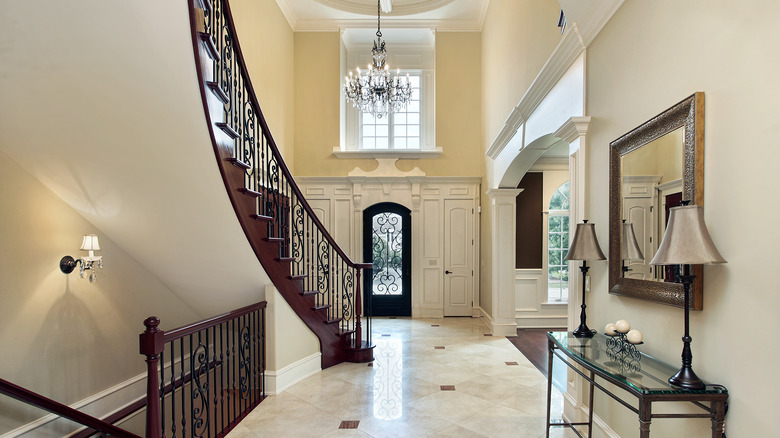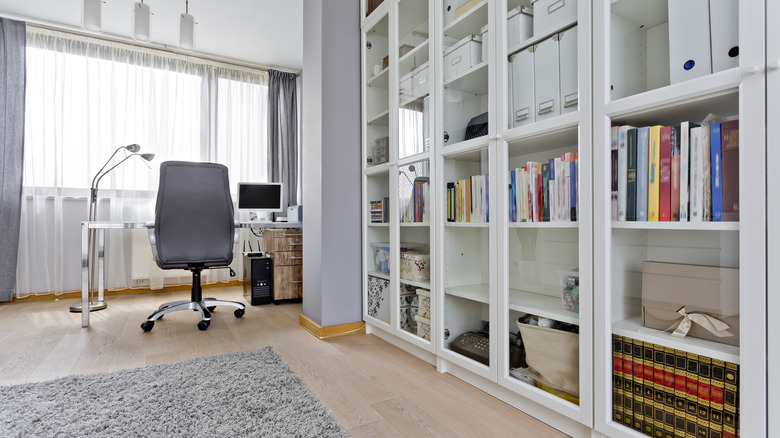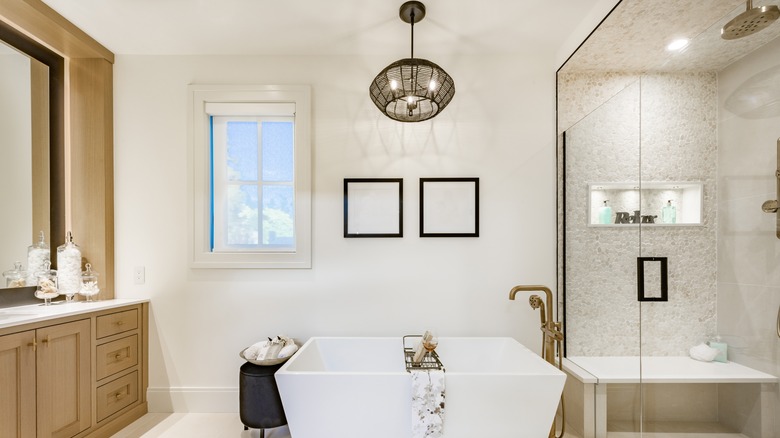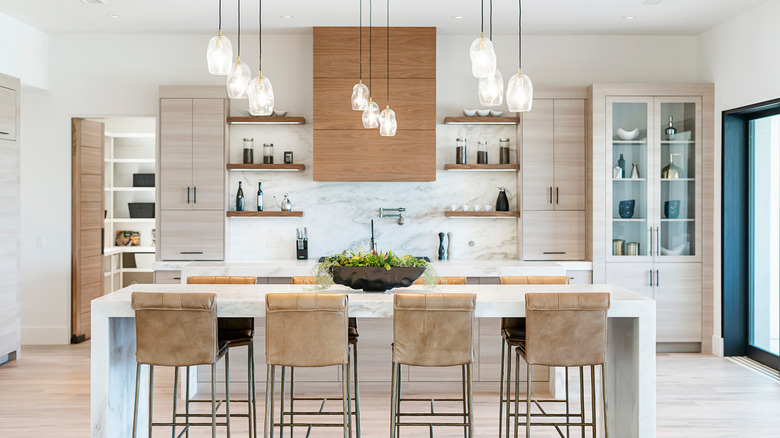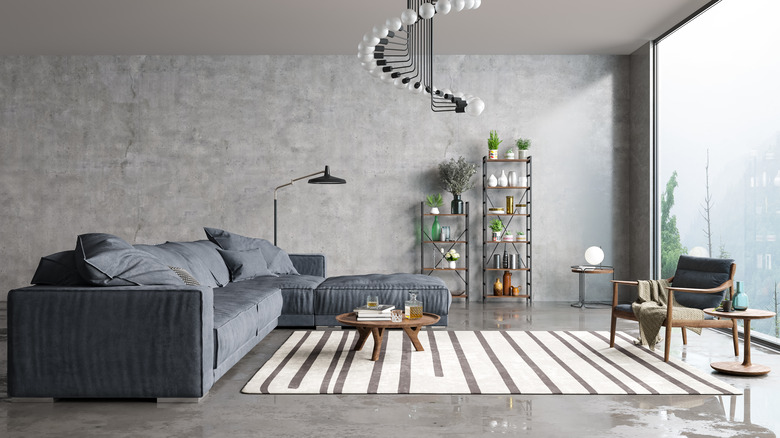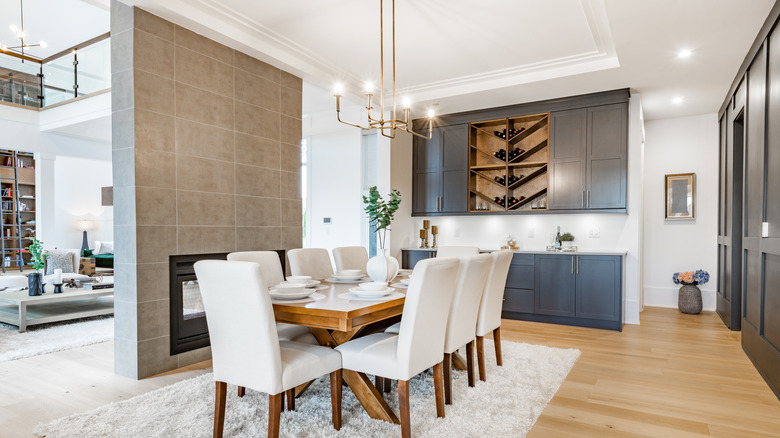How To Add Lighting Room By Room
Whether you're renovating, updating, or decorating, the type of lighting in the room will affect the overall aesthetics and ambiance. The light sources you select for any given room can alter how the tones of color appear in your space. They can cast shadows, illuminate accessories for better viewing, or simply brighten a space up. Lighting is an important interior design element because it can improve functionality and affect the mood in a room. "Lighting is everything, it creates atmosphere, drama, and intrigue in a room," interior designer Martyn Lawrence told Fashion Light Center. With the flick of a switch, you can transform any room in your home. What light do you choose, though? And how many do you need?
When shopping for lighting for your home, it's often the fixtures themselves that attract you the most. They can add depth to your interior design, as the ones you choose can share a little bit about your style. Are you creative? Minimalist? Eco-conscious? Modern? Luxurious? Maybe a blend of a few styles here and there? Either way, there's a light fit for every room of the house. From table lamps to floor lights, chandeliers, and pendant-style fixtures, here are the brightest ways to light up your house by adding the right lighting in each room.
Decide what type of light you need
The key to achieving an attractive interior, day or night, is understanding light management. Beautifully illuminate your space by transitioning the home from natural brightness to artificial illumination by catering to the specific lighting needs of the room. Lighting is not a one size fits all approach when decorating an interior. Each room will have different requirements and capabilities, so adjustments will be made accordingly in your own home. A shaded floor lamp in the corner of your bedroom may be cozy, but the same lamp placed in your living room can appear misplaced.
Lighting's main purpose is to be helpful in the interior. Before buying the first fixture you see, take a look around your room and determine what type of lighting would be most beneficial. Make a list of everything you and others do in the room, like watching movies, reading books, or playing games. Based on the needs of the room, you can begin your light fixture search by selecting a light type fit for the activity. Lighting can be categorized into ambient, task, and accent (via Lowes). You can begin adding a spark of light to your space with comfortable everyday lighting like ceiling fans and floor lamps (ambient), then include oversized pendant fixtures and table lamps (task), and walls sconces and recessed lighting (accent), for a complete mixture of fixtures. Meet your needs in any given space by having a combination of this trio of lighting types.
Multiple light sources is mandatory
The best-designed interiors have more than one light source, and yours should, too. Lighting has a major purpose in an interior, not only for being able to get things done, but also as eye candy. Attractively layered lighting is a significant part of the decorating process. "So having something low, having something at a medium level, and also having something high. It creates visual interest," interior designer Kelly Wearstler told MasterClass. Different levels of lightning fill up negative space in an elegant way all around the room. But how many lights do you need?
The final number of lights in one room will ultimately depend on the square footage and furniture, but if you were already guessing a triad of lights was the recommendation, you would be correct. At least three light fixtures should be in any given space, not just for needs (ambient, task, accent), but also for visual appeal (low, medium, high). The ultimate goal when decorating with lighting is to have enough lighting in the area to accent the space throughout the different times of the day, and to help fill in space in an interesting way. Try not to overdo it, as there is such a thing as too much light.
Create a cozy bedroom atmosphere
A bedroom is one of those areas of the home where dim lighting really goes to work. A low, ambient glow of light works well in a bedroom space. How do you get the glow at home, though? While there are sure to be multiple styles of lighting in any room of the house, there is one particular style that is becoming a staple in contemporary bedrooms that checks the glow box — wall sconces. Whether you screw them into the wall, expose the plug, or tinker with a wireless option, wall sconce fixtures are a fit for the bedside. These wall fixtures, like the double shaded sconce at Rejuvenation, hover above nightstands on either side of a bed to be used for task lighting and getting around in the dark. They do the same job as a table lamp without taking up furniture space.
Wall sconces are not the only light solution for a low glow in the bedroom, though. You can create a dreamy ambiance in your space by decorating with a combination of table lamps and floor lamps. Try adding any of these fixtures to your bedroom with a cone or drum-shaped shade for a timeless appearance that creates a cozy bedroom atmosphere.
Decorate with floor lamps in the living room
Outside of the bedroom, one of the most frequented areas in the house is the living room. It's the largest common room in the home, so it should have lighting that is accommodating for everyone. No one person uses this space the same, so the choice of light is vital. There is sure to be a mixture of fixtures in this space, but here, a floor lamp is almost always mandatory. The height and design of the vertical structure add interest to your space almost immediately. They are the ideal structure to place in the corner of the room, at the corner of a sofa or accent chair. You can even add two of the same style floor lamps in the room to frame a doorway or console table.
Tripod floor lamps like this one at Joss and Main, can add instant warmth to the living area. This floor lamp style is a timeless feature that can blend in almost any decorative preference, from the most basic to the most extreme of interior styles. For a more modern twist on the traditional floor feature, you can consider a floor fixture with a curved appeal or arched post. The tallness of the structure makes it an ideal item in small spaces as it takes up little floor space. Brighten up the living room and create some interest by decorating with a floor lamp or two.
Pick the right size fixture for the dining room
Whether you are hosting a dinner party or just eating breakfast, dining rooms need a fixture that provides ample light. This is the place where meals will be shared, homework will be completed, and celebrations will become memories. Light it up nicely with a statement fixture that hovers above the table. Speaking of tables, what shape is yours? Consider this and any other furnishings or wall décor that exist in this space, as the light fixture you choose shouldn't clash with or block any other elements. Complement a rectangular table with a rectangular candlelit fixture that parallels the shape — this is the congruency you want to aim for when decorating the dining room.
Selecting a light that fits the aesthetic and the room is important to decorating a dining area. What light fixture you choose to display in the dining room depends on the size of the actual room itself. You want to be sure that the fixture doesn't overwhelm or underwhelm the room. "If the dining room has large windows and beautiful views, I would choose a more minimal fixture in size so that I'm not interfering with the view," designer Linc Thelen told HGTV. "If the dining room is large with high ceilings, then I search for a grand fixture to up the space."
Brighten up your hallway with the right light
The hallways of a home are typically windowless and void of any natural light, making the introduction of artificial fixtures paramount. Wall sconces, console table lamps, and pendant lights are ideal fixtures for this area of the home. Your specific hallway features and layout will determine which source of light is best in the space. Not all hallways can accommodate low-hanging lights or furniture for fixtures to rest on. Consider the layout of your hallway and begin your design with functionality in mind.
If your ceiling height allows it, the right pendant light fixtures will be the perfect piece to consume negative space in an artful, luminescent way. When hanging this type of fixture, it should hover at least 7 feet, 6 inches above the floor (via Plank & Pillow). This will keep most people from bumping into it as they walk the corridor. If you can fit a rectangular console table or crescent-shaped accent table in your hallway, then go for it. This would be perfect for an oversized lamp to sit on.
Adjustable lighting in the kitchen
When you're cooking up your favorite meal or grabbing a late snack, the lighting needs to alter in the kitchen. The need for this fluctuation makes the kitchen a prime place for adjustable lighting and multiple light sources. Accommodate this high-traffic area of the house with fixtures that are useful at different times of the day. Overhead lights are bright and common in this spot, but not necessarily a must every time. They're best used for cooking, baking, or cleaning. A soft, delicate glow from an under-the-cabinet light, or even a small lamp on the counter, could be all you need to grab a cookie or brew an early cup of coffee.
If you're up for the challenge, installing a universal dimmer switch in the kitchen is possible while following practical guidelines and instructions (via Easy Do It Yourself Home Improvements). Otherwise, consult the assistance of a certified electrician. These controllable switches provide the functionality of light you never knew you needed. Consider how bright you need the space to be when you need it to be by adjusting the switch on the wall.
Laundry room ambiance
The laundry room is more of a task-oriented area of the home, but with a twist of subtle ambiance mingled in. Not every laundry room has the luxury of outside views, making lighting kind of a big deal here. There is no need for the light in the laundry room to be stadium bright, but it does need to be bright enough for you to measure detergent, fold towels, and find the lost socks in the dryer. A light that's too low will make the space too dark. Not only will the dim light make getting things done here difficult, but it could make the already compact space feel even tighter.
If counter space exists in this room, then consider utilizing small table lamps tucked into a corner for a little bit of light and texture. No counters, no problem, just refocus your lighting efforts toward the ceiling. If space allows, consider one or two pendant-style fixtures for the laundry area. If a low-hanging light isn't desirable, then find a fixture that doesn't dangle at all. A flush-mount fixture as seen on All Modern could be just the right amount of brightness for this area. The close proximity to the ceiling keeps the light out of the way, but is still useful.
Warm entryway welcome
Whether the entry is small or large, lighting is a key feature in this part of the house. Give your guests a warm welcome when they enter your home by accenting the entryway with a stunning light fixture. Even if you already have a console table with a lamp on it, the ceiling light is important, too. These two pieces don't have to match, but they should be complementary and cohesive to the foyer's decorative theme.
The fixture you use at the entryway will be one of the first pieces of décor guests see when they enter, so you may as well make it a showstopper. Chandeliers are home decorators' number one way to spark interest in the entry (via Pottery Barn). Whether candlelight, drum-shaped, iron crafted with shaded lights, or delicate crystal, a chandelier can be an elegant lighting solution perfect for the entryway of a home. They take up space in an area where décor is limited and the environment is confined. A statement light at the entryway can really make the place dazzle.
Add some brightness to a home office bookcase
Inspire productivity and brighten up your home office space with some lighting in a few new areas. Having a dedicated workspace often means you spend some quality time here honing your craft. Good lighting is important when you're working, so opt to add some light to the office area, but not just in the ordinary ways of desk and floor lamps.
Are there any bookcases or shelves in your office space? What better way to illuminate a home office and enhance the aesthetic than by adding some accent lighting underneath the shelves on the wall or under the shelves of a bookcase. Hardwired lighting, low voltage puck lights, or light strips are all possibilities when it comes to brightening a shelf (via Closet Works). There are options for every type of home decorator or DIY extraordinaire. Find the shelf lighting that works for you for the most comfortable workspace.
Relax in your bathroom with spa-like lighting
From lavish to simple, layer light fixtures into your bathroom with style and functionality in mind. The bathroom is where most people start and end their day, so the lighting is often bright to set the stage for day and night. "We all do a lot of closeup work in the bathroom, from brushing to flossing to plucking and applying," designer Gena Kirk told Insider. "If you do not have proper lighting this could go horribly wrong."
The bright light may be best for getting dressed, but how about those evenings when you draw a bubble bath and light scented candles to wind down the day? A dimmer lighting option in this area could really set the mood in your bathroom and make washing away the day like a wellness retreat experience. A mixture of lighting types in this space (bright and dim) allows users to complete tasks and experiences. Wall sconces pair well on the walls with mirrors above vanities, while elegant crystal chandeliers dazzle over tubs. Blend fixtures in the bathroom fit for all days and nights.
How bright do you need the space to be?
Choosing the light fixture or fixtures for any room in the house is an important decision, but the fixture will only be as good as the light it emits. If it is too dark, you can't see; if it's too bright, you don't want to see. Luckily for you, this aspect of interior lighting is somewhat controllable with the right type of bulb and brightness. Before buying the most energy-efficient or traditional light bulb, determine how bright you need it to be.
The brightness will vary depending upon which space you are illuminating in the interior. According to The Home Depot, most common areas such as dining rooms, living rooms, and bedrooms range between 1,000 to 4,000 lumens, while bathrooms and office spaces are brighter, at 6,000 to 8,000 lumens. For each room, try to stay within the recommended lumens range for the best lighting in that area.
Don't match all the fixtures, blend materials
The lamp fixture doesn't have to match the overhead fixture or the floor lamp, and vice versa. In fact, the overall design will appear more organic if these pieces don't match at all. That's right, mix and match the light fixtures in any one room. Avoid matching all the fixtures in the room with the same base or lamp shade shape; rather, choose ones that belong together but don't look alike. Confused? Don't be. Decorating with two or three types of lighting gives you an opportunity to use varying materials and finishes.
When sourcing multiple lights for any space, you want to find the common feature between them all, such as the lampshade color, similarity in silhouette, or material makeup. These commonalities are what will unify the fixtures. Blend a mixture of light fixtures in your space from brass, to woven, glass, metal, and ceramic (via Megan Molten). The eclectic combination of multiple finishes adds stimulation to the interior landscape and boosts its character.
Layer your light fixtures
When adding lighting to a room, it's vital to have multiple pieces, but they need to be varied for an authentic aesthetic. Layering lighting in a room consists of combining different styles of fixtures in order to increase the visual depth and interest in the space (via Studio McGee). You need more than one type or one style of light in the room — layer the light fixtures. This will give you that chic interior-styled aesthetic. That means multiple styles, in multiple finishes, that suffice multiple needs. Got it?
Decorate your home with light fixtures that fill the voids with style and light. You can find the light fixture fit for every tabletop, ceiling, or floor space in your home from a range of styles such as chandeliers, wall sconces, arched floor lamps, and pendant lights. Choose a bulb and a light that's not too bright, not too dark, but just the right amount of brilliance to illuminate all the rooms in your home.
